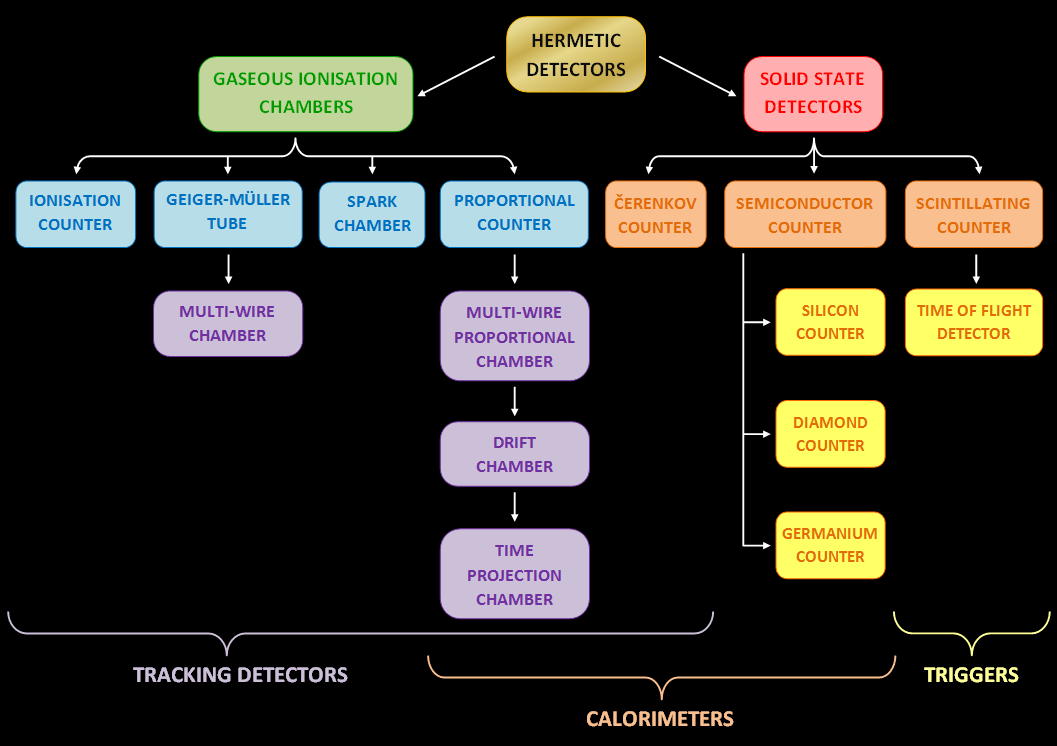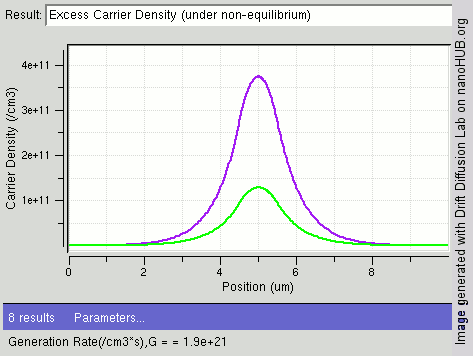|
Charge Sharing
Charge sharing is an effect of signal degradation through transfer of charges from one electronic domain to another. Charge sharing in semiconductor radiation detectors In pixelated semiconductor radiation detectors - such as photon-counting or hybrid-pixel-detectors, charge sharing refers to the diffusion of electrical charges with a negative impact on image quality. Formation of charge sharing In the active detector layer of photon detectors, incident photons are converted to electron-hole pairs via the photoelectric effect. The resulting charge cloud is being accelerated towards the readout electronics via an applied voltage bias. Because of thermic energy and repulsion due to the electric fields inside such a device, the charge cloud diffuses, effectively getting larger in lateral size. In pixelated detectors, this effect can lead to a detection of parts of the initial charge cloud in neighbouring pixels. As the probability for this cross talk increases towards pixel edge ... [...More Info...] [...Related Items...] OR: [Wikipedia] [Google] [Baidu] |
Particle Detector
In experimental and applied particle physics, nuclear physics, and nuclear engineering, a particle detector, also known as a radiation detector, is a device used to detect, track, and/or identify ionizing particles, such as those produced by nuclear decay, cosmic radiation, or reactions in a particle accelerator. Detectors can measure the particle energy and other attributes such as momentum, spin, charge, particle type, in addition to merely registering the presence of the particle. Examples and types Many of the detectors invented and used so far are ionization detectors (of which gaseous ionization detectors and semiconductor detectors are most typical) and scintillation detectors; but other, completely different principles have also been applied, like Čerenkov light and transition radiation. Historical examples * Bubble chamber * Wilson cloud chamber (diffusion chamber) *Photographic plate ;Detectors for radiation protection The following types of particle detec ... [...More Info...] [...Related Items...] OR: [Wikipedia] [Google] [Baidu] |
Photon Counting
Photon counting is a technique in which individual photons are counted using a single-photon detector (SPD). A single-photon detector emits a pulse of signal for each detected photon, in contrast to a normal photodetector, which generates an analog signal proportional to the photon flux. The number of pulses (but not their amplitude) is counted, giving an integer number of photons detected per measurement interval. The counting efficiency is determined by the quantum efficiency and the system's electronic losses. Many photodetectors can be configured to detect individual photons, each with relative advantages and disadvantages. Common types include photomultipliers, geiger counters, single-photon avalanche diodes, superconducting nanowire single-photon detectors, transition edge sensors, and scintillation counters. Charge-coupled devices can be used. Advantages Photon counting eliminates gain noise, where the proportionality constant between analog signal out and number of p ... [...More Info...] [...Related Items...] OR: [Wikipedia] [Google] [Baidu] |
Hybrid Pixel Detector
Hybrid pixel detectors are a type of ionizing radiation detector consisting of an array of diodes based on semiconductor technology and their associated electronics. The term “hybrid” stems from the fact that the two main elements from which these devices are built, the semiconductor sensor and the readout chip (also known as application-specific integrated circuit or ASIC), are manufactured independently and later electrically coupled by means of a bump-bonding process. Ionizing particles are detected as they produce electron-hole pairs through their interaction with the sensor element, usually made of doped silicon or cadmium telluride. The readout ASIC is segmented into pixels containing the necessary electronics to amplify and measure the electrical signals induced by the incoming particles in the sensor layer. Hybrid pixel detectors made to operate in single-photon mode are known as Hybrid Photon Counting Detectors (HPCDs). These detectors are designed to count the number ... [...More Info...] [...Related Items...] OR: [Wikipedia] [Google] [Baidu] |
Electron-hole Pairs
In the solid-state physics of semiconductors, carrier generation and carrier recombination are processes by which mobile charge carriers (electrons and electron holes) are created and eliminated. Carrier generation and recombination processes are fundamental to the operation of many optoelectronic semiconductor devices, such as photodiodes, light-emitting diodes and laser diodes. They are also critical to a full analysis of p-n junction devices such as bipolar junction transistors and p-n junction diodes. The electron–hole pair is the fundamental unit of generation and recombination in inorganic semiconductors, corresponding to an electron transitioning between the valence band and the conduction band where generation of electron is a transition from the valence band to the conduction band and recombination leads to a reverse transition. Overview Like other solids, semiconductor materials have an electronic band structure determined by the crystal properties of the materi ... [...More Info...] [...Related Items...] OR: [Wikipedia] [Google] [Baidu] |
Photoelectric Effect
The photoelectric effect is the emission of electrons when electromagnetic radiation, such as light, hits a material. Electrons emitted in this manner are called photoelectrons. The phenomenon is studied in condensed matter physics, and solid state and quantum chemistry to draw inferences about the properties of atoms, molecules and solids. The effect has found use in electronic devices specialized for light detection and precisely timed electron emission. The experimental results disagree with classical electromagnetism, which predicts that continuous light waves transfer energy to electrons, which would then be emitted when they accumulate enough energy. An alteration in the intensity of light would theoretically change the kinetic energy of the emitted electrons, with sufficiently dim light resulting in a delayed emission. The experimental results instead show that electrons are dislodged only when the light exceeds a certain frequency—regardless of the light's intensity o ... [...More Info...] [...Related Items...] OR: [Wikipedia] [Google] [Baidu] |
Signal Integrity
Signal integrity or SI is a set of measures of the quality of an electrical signal. In digital electronics, a stream of binary values is represented by a voltage (or current) waveform. However, digital signals are fundamentally analog in nature, and all signals are subject to effects such as noise, distortion, and loss. Over short distances and at low bit rates, a simple conductor can transmit this with sufficient fidelity. At high bit rates and over longer distances or through various mediums, various effects can degrade the electrical signal to the point where errors occur and the system or device fails. Signal integrity engineering is the task of analyzing and mitigating these effects. It is an important activity at all levels of electronics packaging and assembly, from internal connections of an integrated circuit (IC), A survey of the field of electronic design automation. Portions of IC section of this article were derived (with permission) from Vol II, Chapter 21, ''No ... [...More Info...] [...Related Items...] OR: [Wikipedia] [Google] [Baidu] |
Domino Logic
Domino logic is a CMOS-based evolution of the dynamic logic techniques based on either PMOS or NMOS transistor upright=1.4, gate (G), body (B), source (S) and drain (D) terminals. The gate is separated from the body by an insulating layer (pink). A transistor is a semiconductor device used to Electronic amplifier, amplify or electronic switch, switch ...s. It allows a rail-to-rail logic swing. It was developed to speed up circuits, solving the premature cascade problem, typically by inserting small and fast pFETs between domino stages to constrain the interstage cascade velocity to a curtailed maximum—a curtailed ''deterministic'' maximum—without requiring other circuit design interlocks. Terminology The term derives from the fact that in domino logic (cascade structure consisting of several stages), each stage ripples the next stage for evaluation, similar to dominoes falling one after the other. Dynamic logic drawbacks In dynamic logic, a problem arises when ... [...More Info...] [...Related Items...] OR: [Wikipedia] [Google] [Baidu] |
Digital Circuits
Digital electronics is a field of electronics involving the study of digital signals and the engineering of devices that use or produce them. This is in contrast to analog electronics and analog signals. Digital electronic circuits are usually made from large assemblies of logic gates, often packaged in integrated circuits. Complex devices may have simple electronic representations of Boolean logic functions. History The binary number system was refined by Gottfried Wilhelm Leibniz (published in 1705) and he also established that by using the binary system, the principles of arithmetic and logic could be joined. Digital logic as we know it was the brain-child of George Boole in the mid 19th century. In an 1886 letter, Charles Sanders Peirce described how logical operations could be carried out by electrical switching circuits.Peirce, C. S., "Letter, Peirce to A. Marquand", dated 1886, '' Writings of Charles S. Peirce'', v. 5, 1993, pp. 541–3. GooglPreview See Burks, Arthu ... [...More Info...] [...Related Items...] OR: [Wikipedia] [Google] [Baidu] |

.jpg)

